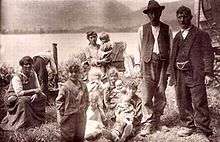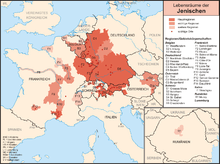Yenish people



The Yenish, Yeniche (French spelling), or Jenische (German spelling), are the third-largest population of nomadic people all over Europe, living mostly in Germany, Austria, Switzerland, Luxembourg, Belgium and parts of France. They are one of the most geographically widespread groups in Western Europe. They often claim to be descendants of the Celtic Helvetii, but it is commonly believed that the origin of the Yenish can be attributed to members of the marginalized and poor classes of society of the early modern period and the 19th century. Features of this historic Yenish were their economic, legal and social exclusion from the majority population and a consequent permanent migration. In this regard and also in their lifestyle, they resemble the Scottish and Irish Travellers. There are about 700,000 Yenish people all over Europe, over 200,000 in Germany, 35,000 in Switzerland, 3,000 in Luxembourg and the rest spread all over France, Belgium, and Austria. In the Netherlands the 'Woonwagenbewoners' are a small community of travelling families related to the Yenish people. In Romania the Yenish are known as 'deitsche Zigeiner' which means 'German Gypsies'. In Pennsylvania there are Yenish families with roots in Switzerland, Germany and Luxembourg. They are called Dutch Gypsies or Black Dutch.
Culture
The Yenish have been concentrated mostly around the Rhineland.
The Yenish differ culturally and ethnically from the Roma and are considered a different group, although they may fall under a more generic but often more loosely defined category of Gypsy. They live within extended families.
Their Yenish language or jargon (argot, cant) is essentially the Rotwelsch language enriched with distinctive vocabulary, partially based on other languages like Yiddish, Judeo-Latin, and Romani.
The adjective jenisch is first attested in the early 18th century in reference to a jargon of this kind. Use as a self-designation arose by the end of the 18th century, first recorded by Johann Ulrich Schöll, who published a treatise on itinerant groups in Swabia in 1793.
Traditionally, many Yenish lived in horse-drawn wagons (vardos) and worked as transient farm workers, street musicians, circus and fairground showpeople or made and sold arts & crafts.
Switzerland
Today 35,000 Yenish live in Switzerland, mostly concentrated around Graubünden. Only about 5,000 of them currently live the traditional traveller lifestyle.
Until the 1970s, the Swiss government had a semi-official policy of institutionalizing Yenish parents and having their children adopted by more "normal" Swiss citizens, in an effort to eliminate Yenish culture.[1] The name of this program was Kinder der Landstrasse ("children of the road"). In all, 590 children were taken from their parents and institutionalized in orphanages, mental institutions and even prisons.[2]
Famous Yenish
- Stephan Eicher, Musician
- Venanz Nobel, Writer
- Romed Mungenast, Writer
- Engelbert Wittich, Writer and Poet (19. century)
- Mariella Mehr, Writer
- Simone Schönett, Writer
- Counousse, Musician from Switzerland
- Rafael van der Vaart, Footballer
- Albert Minder, Poet and Writer
- Oliver Kayser, Musician and Variete Performer
- Jean Clement, Circus Clown
- Fränzli Waser, Musician
- Walter Wegmüller, Artist
- Christoph Dettinger, professional Boxer from France
Yenish organisations
- Radgenossenschaft der Landstrasse (Switzerland)
- Jenischer Kulturverband (Austria)
- Jenischer Bund in Deutschland und Europa (Germany)
Film and television
- 1957: Es geschah am hellichten Tag
- 1979: Das gefrorene Herz
- 1992: Kinder der Landstrasse
- 2008: Hunkeler macht Sachen
See also
| Wikimedia Commons has media related to Yeniche. |
- Yeniche language
- Indigenous Norwegian Travellers
- Irish Travellers
- Romani people
- Scottish Travellers
- Quinqui jargon
Sources
- ↑ On Swiss Crimes against Yenish (in German)
- ↑ Le Temps (Geneva), December 12, 2007, "Le passé enfin écrit des enfants enlevés en Suisse", an historical study spanning the years from 1926 to 1973.